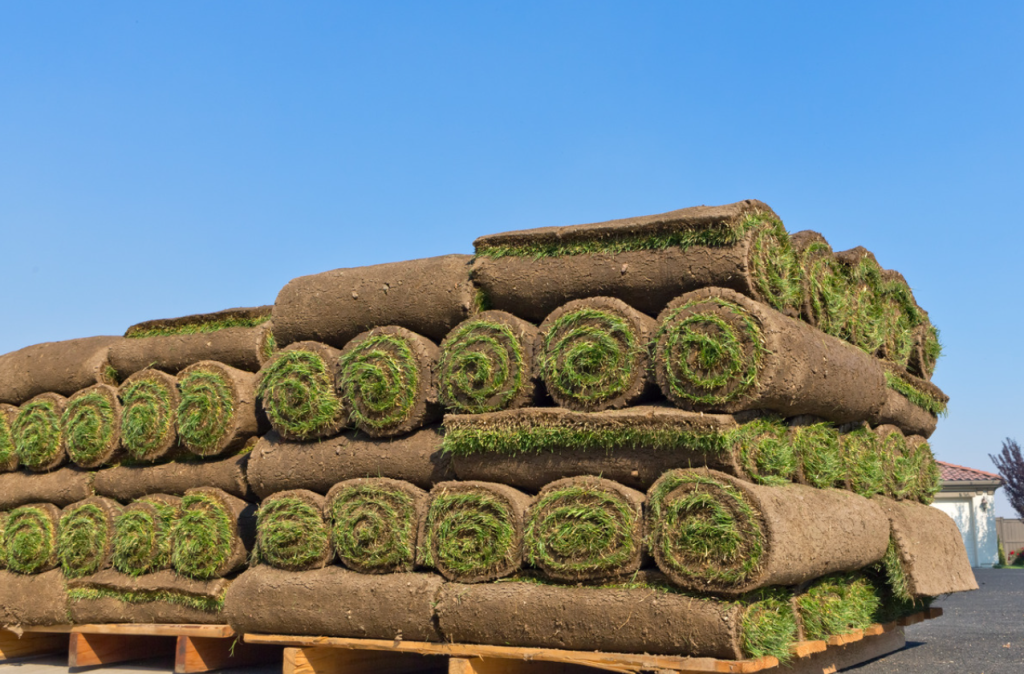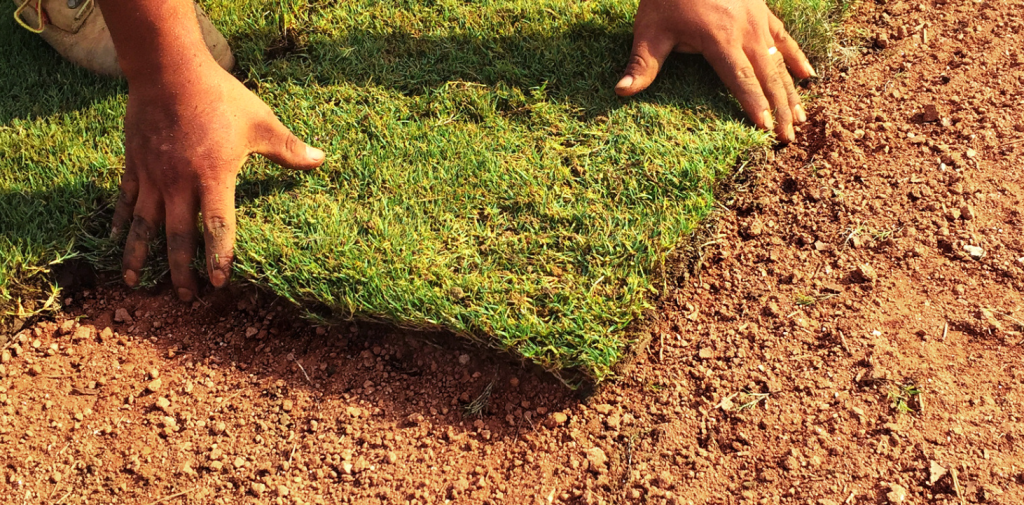Are you looking for sod installation “Near Me,” aka Savannah and Pooler? Wherever you live in Chatham or Bryan County, Sod Installation is one of those things you most likely want to leave to the pros!
While it may seem simple, laying sod is labor-intensive and more challenging than the average homeowner might expect. From preparing the ground for sod installation to purchasing sod and laying it, the process isn’t complicated – it is just time-consuming.
Today, the team here at Coastal Hardscapes will walk you through our sod installation process, including the prep work, costs, and how to make your lawn look amazing effectively!
First, what is Sod?

Sometimes referred to as turf grass, sod is grass that is pre-grown on a sod farm that is later cut and sold. Sod grass comes in rolls and is pre-grown for you so you don’t have to worry about planting new seeds and waiting.
The average sod rolls cover almost 3 square feet and are rectangular in shape when unrolled. If you are considering a sod installation project, you will want to always make sure you have the right amount of sod, and prior to laying sod, be sure the ground is ready and prepped.
Step 1: Sod Pre-Installation Preparation

Depending on the state of your existing turf or lack thereof, proper prep work is required before you lay any sod. Whether you live in Savannah or somewhere up north, sod laid on top of bad soil or existing grass will most likely die. Here at Coastal Hardscapes, since we complete so many patios and walkways, typically after we are done, we sod the areas around the hardscaping. Our process is always as follows:
A. Removing Existing Grass
- We remove any existing grass or vegetation to ensure a clean slate for the new sod.
- Remove rocks, debris, trash, or other items, such as sticks, from the soil beneath the new sod.
- We are careful not to damage the underlying soil.
B. Soil Testing and Preparation
- We test your soil to determine its pH level and nutrient content – this helps with longevity.
- Add necessary amendments to adjust the soil’s pH and nutrient levels (this does cost extra if required)
- Loosen the top layers of the soil to create a well-aerated base for the sod.
Once we prep the area for sod, the next step is to purchase the sod and install it!
Step 2: Choosing the Right Sod
Which is the best sod choice for your house or business? The answer to that question really starts with climate. In the Coastal Georgia region, Centipede, Bermuda, and St. Augustine are the most common choices for a thriving lawn. If you were to install a Kentucky Bluegrass or Fescue, you would deal with drought issues since they are intolerant of the heat. Here is how to pick sod:
Types of Sod & Where to Buy:
For Savannah, Pooler, Hilton Head, and the Southeast, St. Augustine, Centipede, and Bermuda are the best fit for your climate and lawn type. We like Centipede grasses the most because it does excellent with heat tolerance and is deficient in maintenance. Most of these southern grasses require water, heat, and fertilizer. They are considered crawling grass with thick sods and spread by stolons.
When it comes to buying sod, a landscaping company can help you get a bulk order at a cheaper cost vs you going to a hardware store. Professional landscaping companies know what to look for regarding quality.
Step 3: Laying Sod

Once we prep the area and order your sod, the next logical step is to lay sod around your yard. There is a strategy in how you lay sod so that seams don’t line up. The step-by-step process is as follows:
- We lay the sod in a brick-like pattern, staggering the seams to prevent them from lining up.
- Our technique starts by laying the first row along the longest straight edge in your yard.
- Use a snap-off razor knife to slice the sod and fit it around curves and edges.
- Use a rake to smooth out the surface and create a seamless transition between sod pieces.
When it comes to sod installation services, professional landscaping companies like Coastal Hardscapes can help you with the best strategy for your sod installation and new lawn. In some cases, as a cost-cutting measure, you can sod in high-traffic areas and in the front but seed in the back. There are always multiple options to explore.
Step 4: Post-Installation Care
Once your sod is installed, it is up to you to care for the sod appropriately. This means heavy watering, low traffic, and more watering. Here are some maintenance tips:
- Water the newly installed sod thoroughly immediately after laying. Water for longer sessions less often is more important to encourage deeper root growth.
- Keep the soil consistently moist during the first few weeks after installation.
- Do not fertilize too soon! Let the grass grow and wait to mow 3-4 weeks to really let the sod take.
Ongoing Maintenance
- Maintain a regular watering schedule to keep the sod healthy and thriving. A thorough watering 2x a week is better than a daily quick hit of water.
- Mow the sod at the recommended height to promote healthy growth. The best thing to do is to research the proper height for your grass.
- Fertilize the sod regularly to provide essential nutrients. A fertilizing schedule can be found at your local hardware store and consists of pre-emergent weed control, nitrogen, and other fertilizers.
Finding a Sod Company in Savannah, Pooler, Richmond Hill:
The average lawn looks less than desirable due to maintenance. However, a proper start is key which is why the extra costs of installing sod vs. seed is worth the investment long-term. Seeding a yard can take 2-3 years to fully fill in and this is after seeding several more times and heavy maintenance.
When you buy sod, it is best to work with a sod installation company that specializes in bulk sod installation. To find a sod company in the Savannah area, you can take the following tips:
- Search online. Chances are that is how you found this article!
- Visit a local garden center and ask about sod installation companies in Pooler or Savannah.
- Ask a local mowing company or neighbor
Sod Installation Cost:
Sod installation costs are based on the size of the area you want to lay sod. Prep work, purchasing the sod, delivery fees, and installation of new sod is factored into our pricing and we charge a set price per square foot. As the square footage increases, it requires more sod. However, the cost is reduced for bulk orders.
Sod Pricing:
- Bulk sod costs $.30-$.80 per square foot, and retail sod can go for $1-$2 per square foot
- Installing the sod, which includes prep work, typically starts at $1.50 per square foot
If you have to lay sod in an area more than 15 square feet, it is best to contact a professional sod company in Savannah/Pooler using the tips from above.
Enhancing Curb Appeal with Sod
When you install sod, you will immediately enhance the curb appeal of your home and increase its value. In the long run, the curb appeal is worth it, and sod ends up being cheaper than seeding after the labor behind seed and straw. To increase your curb appeal further, consider adding other landscaping features, such as flowers or trees, to complement the sod. After installation, regularly maintain the sod to keep it healthy and thriving!
To get a quote for sod installation, topsoil refinement, and other landscaping services, you can reach out to the team here at Coastal Hardscapes & Landscaping below:
Frequently Asked Questions:
1. How much does new sod cost to install?
Sod installation services vary based on the size of the project, and costs are typically based on square footage. First, we must estimate the cost of sod installation based on the size of your lawn and the type of sod you choose. A single piece of sod is 16″ x 24″, which equals 2.75 square feet, and sod is usually purchased in 500 square foot pallets.
Cost factors that must be considered include labor costs, soil preparation, the sod itself, and delivery fees. Factoring all of these, the average cost to install and prep the area for one pallet of sod ranges from $500 to $1,000, with the average being around $750. Essentially sod installation costs start at $1.50 and go up to $3.00 per square foot.
2. When is the best time of year to install sod?
While the seasons matter more in the north than the south, the ideal time to install sod is during the spring or early summer when temperatures are not too hot or cold. The goal is always to avoid installing sod during extreme weather conditions, such as heavy rain or drought. In Savannah, Pooler, and the surrounding areas, the warm weather in the summers is actually ideal for St. Augustine, Bermuda, and Centipede grasses. However, they require heavy watering after installation.
3. Should I install sod myself? DIY vs. Professional Installation:
If you need to patch a few spots in your lawn, chances are you can handle that on your own. For those with an existing lawn that is in serious need of rejuvenation, consider hiring a professional for sod installation if you are not experienced with DIY projects. The prep work itself can take an entire day for a professional crew to prepare the ground before laying sod. A common mistake homeowners make is laying sod on top of grass, which can kill the sod. While DIY sod installation can save money, it requires the necessary skills and experience. Ultimately, the team here at Coastal Hardscapes says to weigh the pros and cons of DIY vs. professional installation before making a decision.


 The 7 Best Landscaping Companies in Savannah, GA
The 7 Best Landscaping Companies in Savannah, GA
Leave a Reply